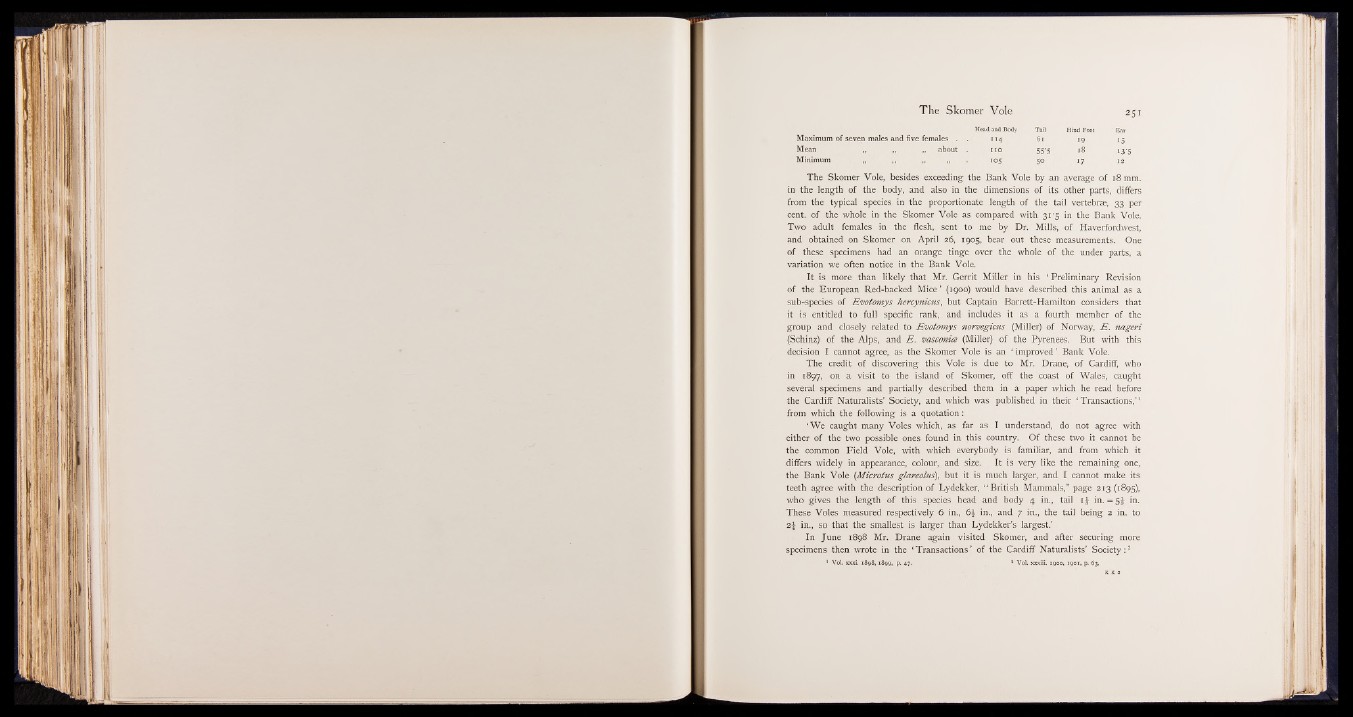
The Skomer Vole 251
Head and Body Tail Hind Foot ' Ear
Maximum of seven males and five females . 1 1 4 6l 19 15 Mean ^ „ „ about . n o 55' $ 18 I 3-5 Minimum ,, „ 105 50 17 12
The Skomer Vole, besides exceeding the Bank Vole by an average of 18 mm.
in the length of the body, and also in the dimensions of its other parts, differs
from the typical species in the proportionate length of the tail vertebrae, 33 per
cent, of the whole in the Skomer Vole as compared with 31*5 in the Bank Vole.
Two adult females in the flesh,, sent to me by Dr. Mills, of Haverfordwest,
and obtained on Skomer on April 26, 1905, bear out these measurements. One
of these specimens had an orange tinge, over the whole of the under parts, a
variation we often notice in the Bank Vole.
It is more than likely that Mr. Gerrit Miller in his ‘ Preliminary Revision
of the European Red-backed Mice ’ (1900) would have described this animal as a
sub-species of Evotomys hercynicus, but Captain Barrett-Hamilton considers that
it is entitled to full specific rank, and includes it as a fourth member of the
group and closely related to Evotomys norvegicus (Miller) of Norway, E . nageri
(Schinz) of the Alps, and E . vasconiee (Miller) of the Pyrenees. But with this
decision I cannot agree, as the Skomer Vole is an ‘ improved ’ Bank Vole.
The credit of discovering this Vole is due to Mr. Drane, of Cardiff, who
in 1897, on a visit to the island of Skomer, off the coast of Wales, caught
several specimens and partially described them in a paper which he read before
the Cardiff Naturalists’ Society, and which was published in their ‘ Transactions,’ 1
from which the following is a quotation:
‘We caught many Voles which, as far as I understand, do not agree with
either of the two possible ones found in this country. Of these two it cannot be
the common Field Vole, with which everybody is familiar, and from which it
differs widely in appearance, colour, and size. It is very like the remaining one,
the Bank Vole (M icrotus glareolus), but it is much larger, and I cannot make its
teeth agree with the description of Lydekker, “ British Mammals,” page 2 13 (1895),
who gives the length of this species head and body 4 in., tail i£ in. = 5^ in.
These Voles measured respectively 6 in., 6£ in., and 7 in., the tail being 2 in. to
21 in., so that the smallest is larger than Lydekker’s largest.’
In June 1898 Mr. Drane again visited Skomer, and after securing more
specimens then wrote in the ‘ Transactions’ of the Cardiff Naturalists’ Society:2
1 Vol. xxxi. 1898,1899, p. 47. s Vol. xxxiii. 1900, 1901, p. 63.